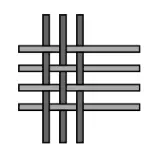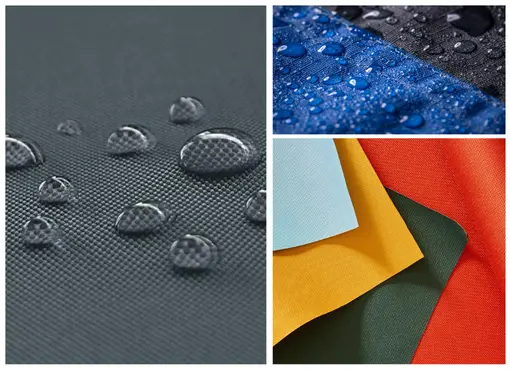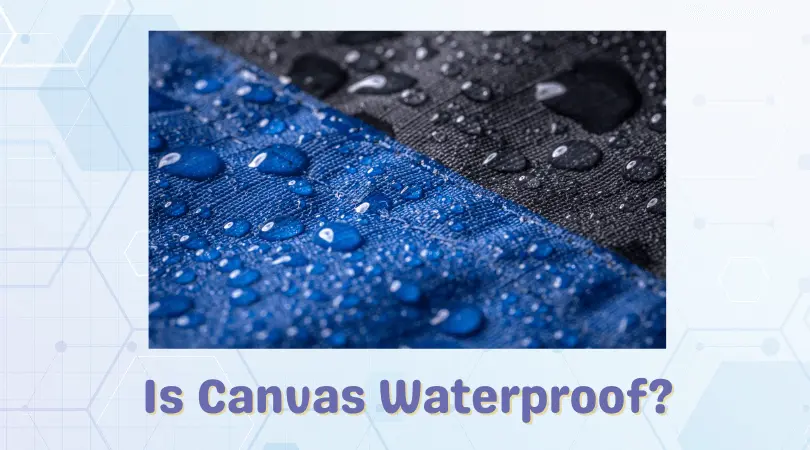We’ve all probably painted on a canvas at some point. However, have we paused to wonder what canvas is? This article aims to illuminate the subject while delving into the different types of canvas material and their properties.

Canvas is a durable, plain-woven fabric made from cotton or linen. Manufacturers also use polyvinyl chloride (PVC) and hemp to make canvas-based products. The word canvas comes from the 13th-century Anglo-French term canevaz or earlier from the Latin term cannapaceus (made from hemp). It differs from other heavy cotton fabrics, such as denim, in that it is plain-woven, as shown in the figure. Duck canvas is a tightly woven variant of canvas material. Canvas is usually classified by weight or by a graded number system.
Canvas is an umbrella term used to describe sturdy, highly durable, and water-resistant fabric. The earliest use of canvasses dates back to 4000 years ago, with the Egyptians using woven canvas as a sailcloth on their boats to traverse the river, Nile. Generations of native American peoples have cut semi-circular canvas shapes as roofs stretched over wood in Tipis.
Renaissance painters in Venice and later the Dutch masters used canvas stretched over wood to create picturesque oil paintings. Canvas was preferred over wood panels due to its relative inexpensiveness and availability and ability to resist wear. China and India dominate the canvas market; the former heavily manufactures and exports canvas fabric, while the latter mainly produces cotton-based canvas material. China is the world’s largest producer of linen and industrial hemp fiber.
In modern times, canvas is used widely in clothing, shoes, marine equipment, shelter, embroidery, and painting mediums. Over time, synthetic materials such as PVC and polyester have been blended in to increase the resistance and durability of canvas material to harsh conditions.
Clothing and outdoor gear today feature water-resistant or water-repellant tags. Canvas-based outdoor gear manufacturers label their products as waterproof or water-resistant. Let us dive deeper into canvas’s water-resistant features in the next section.
CANVAS: WATER RESISTANT OR WATERPROOF?

A water-resistant fabric or material functions very differently from a waterproof one. The word ‘resistance’ might suggest a tendency to keep all of the water out; however, this isn’t entirely true.
Water-resistant fabrics and materials may prevent the penetration of water molecules but only to a certain extent. Cotton or linen materials may be water-resistant, but they aren’t entirely impervious to water in extreme weather conditions. Cotton possesses excellent water resistance qualities in that the threads absorb and retain water but fail to prevent seepage through the fabric.
Waterproof materials or clothing items will protect the product or wearer from moisture and water for a significant period. Canvas is primarily made from cotton and linen, making it water-resistant and not waterproof.
Canvas membranes tighten up when exposed to water, keeping it out for a while. Upon further exposure to the elements, the ability to withstand water becomes minimal, leaving the material soaked and soggy. To avoid this, innovators have sprung up solutions to make canvas waterproof. Let us see how in the next section.
HOW TO MAKE CANVAS WATERPROOF?
We’ve established the versatility of the canvas. Canvas product manufacturers employ a series of ‘blends’ to improve the fabric; adding features that make canvas more suitable for extreme conditions. For example, a typical fabric can be meshed with aramid fibers to produce composite-based ballistic vests. Gel coatings and sprays can be used to make canvas material waterproof.
Both natural and synthetic methods can be employed to enhance the hydrophobic nature of the fabric. Manufactured products such as petroleum-based sealants, DWR (Durable Water-Repellant) coatings, and fluoro-carbon sprays are viable waterproofing solutions. Natural products such as linseed oil and beeswax mix are prepared before coating to make the canvas waterproof.
Consumers can use the waterproofing solutions mentioned below based on availability, type of canvas material, and product type, i.e., the nature of the product in terms of size, shape, and use.
Natural canvas waterproofing solutions:

- Waxes are a type of hydrophobic lipid. They’re made of molecules consisting of long-chain fatty acids bound to a long-chain alcohol via ester oxygen. These molecules do not mix with the water being polar opposites, and are entirely water-insoluble. The water-repellant nature of wax makes it well-suited for waterproofing solutions.
A mixture of beeswax and paraffin wax can be blended to obtain a mix suited for cotton-based canvas material. Clothes, shoes, or outdoor gear can be coated with wax to protect effectively against the elements. Canvas users can engage in a fun DIY activity using household appliances such as hairdryers and paintbrushes to make their canvas products waterproof using wax.
- Linseed Oil has been a household feature for quite some time now. Wooden furniture is coated with linseed oil to protect the surface from moisture and rot. More oversized products, such as tents and awnings, can be double-coated with linseed oil to obtain water-repellant properties.
Synthetic canvas waterproofing solutions:
- Petroleum-based polymer sealants in sprays or liquid form can be used to coat canvas-based outdoor gear and marine equipment thoroughly. It gives the surface layer a waterproof finish to keep the water out.
- DWRs or durable water-repellants such as Silicone can be cyclically applied on the pure cotton-based canvas to achieve hydrophobic features. Derivative silicone sprays provide an effective top barrier to prevent water from seeping into the cotton threads underneath.
- Fluoropolymers are long-chain compounds that are water-repellant. Their non-polar structure repels water molecules. Sprays containing these compounds are cheap, readily available, and easy to use.
CONCLUSION
Canvas is a versatile fabric mainly made of cotton, flax, and hemp fibers. Canvas-based products are incredibly durable and water resistant to some degree. Adventurers and other consumers can also use canvas made from synthetic blends such as polyester and acrylic as alternatives in extreme conditions to cotton or hemp-based canvas owing to their designated hydrophobic nature.
Water-resistant fabrics can be made entirely waterproof using various layering solutions. In this context, waxes, sprays, and gels can be used to create a hydrophobic top layer that protects the canvas threads underneath.



